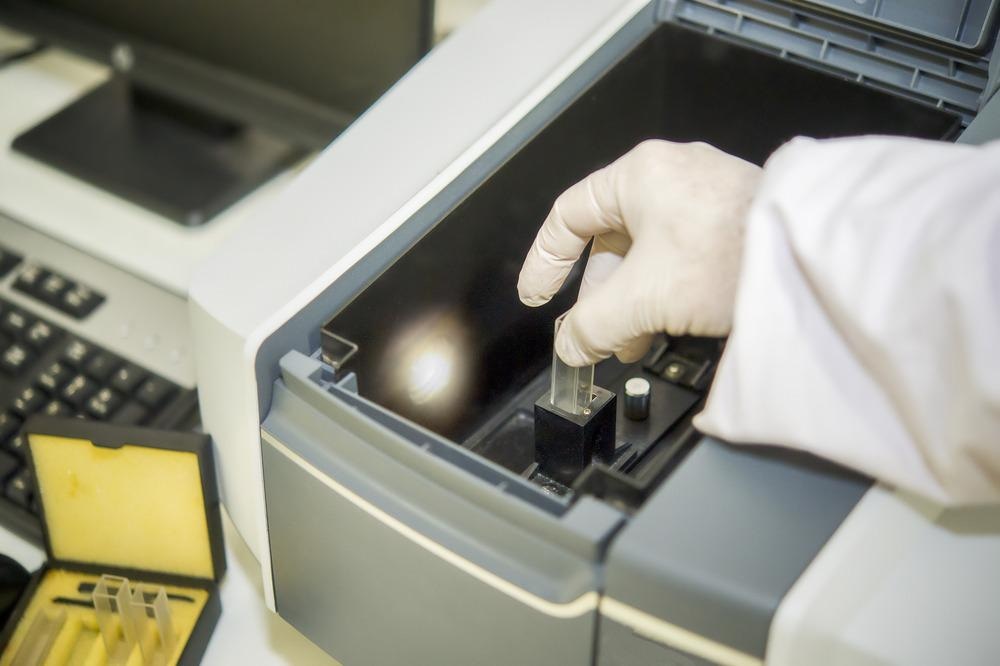A new finding in infrared (IR) spectroscopy using nanotechnology is described in the journal Nanophotonics.

Study: Nanostructure-enhanced infrared spectroscopy. Image Credit: Rabbitmindphoto/Shutterstock.com
Although infrared spectroscopy is a robust technique for obtaining molecular data such as chemical components and structural characteristics of analytes, it has a low water absorption cross-section, which leads to low sensitivity and poor signal-to-noise (S/N) or signal-to-background (S/B) ratios.
Infrared Spectroscopy and Its Usage
We can learn a lot more about the substance by measuring the spectrum of color with spectroscopy. Because the infrared (IR) wavelength corresponds to that of molecular vibration and rotary movement, the IR spectrum depends on materials' chemical structure and components.
As a result, IR spectroscopy is an important technique widely employed in various domains such as chemistry, biology, environmental research, and mechatronics.
It also has uses in safety, food, and material identification and is utilized to investigate and identify chemical compounds or molecular structures that exist in solid, liquid, or gaseous phases.
Infrared spectroscopy is a dependable and straightforward technique used for a range of tests and quality control in both research and practical applications.
The Limitation of IR Spectroscopy
However, since the absorption cross-section of particles in the infrared spectral range is significantly small and all heat objects around us always emit IR light, IR spectroscopy suffers from low signal intensity and highly undesirable backgrounds and noise, resulting in lower signal-to-noise and signal-to-background ratios.
As a result, measuring a tiny number of analytes is difficult. Some solutions have been devised, such as attenuated total reflectance (ATR) and grazed incidence reflectance. Reflection absorption spectroscopy (RAS), for example, is a grazing incidence reflectance method.
Improving the Technique using SEIRA
Several ways have been devised to improve the weak signals from particles. The transforming growth properties of plasmon resonance at microscopic metal particles/structures are used to improve IR signals in surface-enhanced IR absorption (SEIRA).
Resonant SEIRA takes advantage of resonant interaction between metal structure broadband surface plasmon resonance and narrowband vibrational signals of molecules.
The most significant contribution to SEIRA is the local augmentation of electromagnetic fields. In the mid-infrared (MIR) region, plasmonic nanostructures are exceedingly good field enhancers that efficiently limit incoming infrared electromagnetic energy in their proximity.
Plasmon resonances around the same frequency as molecule vibration may be found in specific MIR-resonant metal nanostructures.
Dielectric Nanoantenna with SEIRA
For very sensitive SEIRA spectroscopy, all-dielectric nanoparticles with a higher index of refraction have recently been developed as an alternative to plasmonic nanostructures. Because of their large indices, dielectric nanostructures enable strong field amplification and confinement in their vicinity.
Another important feature of resonant dielectric nanostructures is their low optical loss in the MIR region, which results in a far greater quality (Q) factor than plasmonic devices. Because of their high indices and exceptionally low loss in the MIR region, Si and germanium (Ge) is the most extensively employed dielectric substances among many dielectric materials.
As they display plasmonic activity, heavily doped semiconductor materials are also potential MIR ring resonators for SEIRA. By loading and/or carrier injection, the resonating wavelengths can be adjusted to encompass the MIR area, albeit MIR resonance necessitates substantial doping concentration.
Doped semiconductors also gain from well-established semiconductor production and synthesis processes, resulting in high-quality and low-cost resonance nanostructure creation.
Advances in IR Nanotechnology
Particular metallic nanostructures with MIR resonances produce plasmonic resonances around the same frequency as molecular vibration.
In the last two decades, significant advances in nanotechnology techniques have resulted in more structured nanostructures with well-defined geometric shapes (shape, size, and arrangement), allowing for precise and fine controls of electromagnetic resonances across specific vibrational frequency varies in the MIR regime.
As SEIRA-active nanomaterials, rod-like metallic nanoantennas have been widely used among nanomaterials. Metallic nanorods rely on longitudinally dipole resonances, leading to substantial field enhancement at both ends.
SEIRA Advantages
Boosting near-field coupling with the sample molecule's IR absorption mode is critical to further improving SEIRA signals. Because it exposes an augmented electric field to the vacuum easily accessible by analyte molecules, elevating metamaterial structures well above substrates is a realistic and effective technique to improve SEIRA and surface plasmon detectors.
Continue reading: The Benefits of AFM for Nanoparticle Research.
Reference
Tanaka, T., et al. (2021) Nanostructure-enhanced infrared spectroscopy. Nanophotonics. Available at: https://www.degruyter.com/document/doi/10.1515/nanoph-2021-0661/html
Disclaimer: The views expressed here are those of the author expressed in their private capacity and do not necessarily represent the views of AZoM.com Limited T/A AZoNetwork the owner and operator of this website. This disclaimer forms part of the Terms and conditions of use of this website.